
Honest La Guajira Tour Review
TL;DR
This raw and honest review of our La Guajira’s 3-day desert adventure reveals stunning landscapes, challenging roads, and a reality check you won’t find in glossy brochures.
Planning a trip to La Guajira? But what’s it really like to experience Colombia’s wildest region? That’s what our honest review is here to uncover.
You’ve probably noticed that most agencies offer the same tour so we joined a typical 3-day La Guajira tour that took us to Cabo de la Vela, the Taroa Dunes, and Punta Gallinas. And while the desert landscapes were as breathtaking as promised, the journey itself came with some surprises – both good and challenging.
If you’re wondering whether this adventure is worth your time, money, and energy, you’re in the right place. We’ll walk you through the full itinerary, share real photos, highlight the realities (like road blockages and sleeping in hammocks), and help you decide if La Guajira is the right fit for your travel style.
La Guajira Tour Review
How to Tour La Guajira
The truth is that most travel agencies offer the exact same tour. We kept seeing the same groups at the same stops at the same times. The accommodations are switched frequently to distribute business equally throughout the area. This is the tour we did:
La Guajira Map
La Guajira Tour Itinerary
This is the itinerary we did, it might diverge from the one you find online:
Day 1 – Manaure, Dorada Beach, Pilón de Azúcar & Cabo de la Vela
Morning: We were picked up at our accommodation in time and started our drive to our first stop, the Manaure Salt Flats. Here, we did a tour where we learned about the production of salt and had a lot of photo-ops.
Afterwards, we drove to Uribia to shop for the last necessities before the desert.
Our delicious lunch with a sea view was served in Cabo de la Vela.
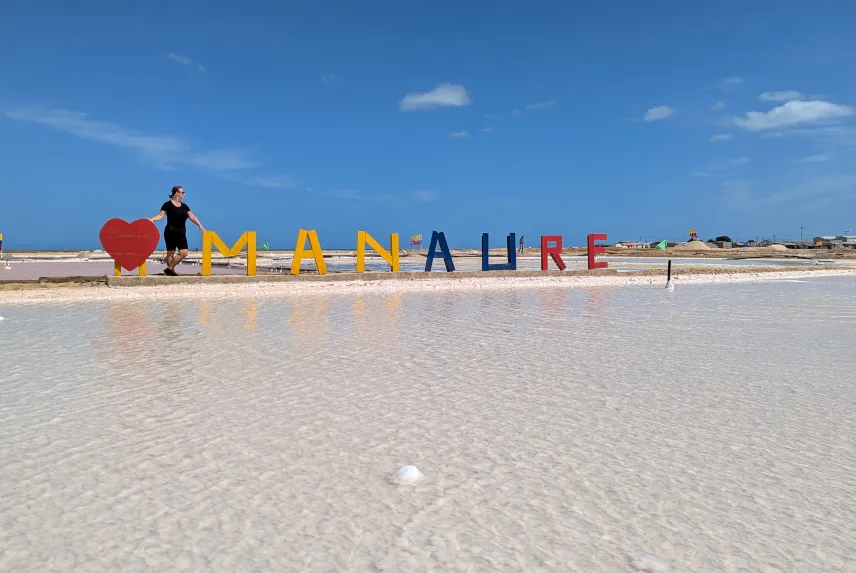
Afternoon: After lunch, we went to Dorada Beach and Pilón de Azúcar. First, we hiked up Pilón de Azúcar to enjoy 360-degree views across the La Guajira Desert. Afterwards, we took a refreshing dip at Playa Dorada.
Our group spent too much time at Dorada Beach so we only had time for a quick pit stop at Ojo de Agua Beach because we didn’t want to miss the sunset.
We watched the sunset at the lighthouse of Cabo de la Vela. Afterwards, we were dropped off at our accommodation in Cabo de La Vela where we enjoyed a delicious dinner and went to bed early.
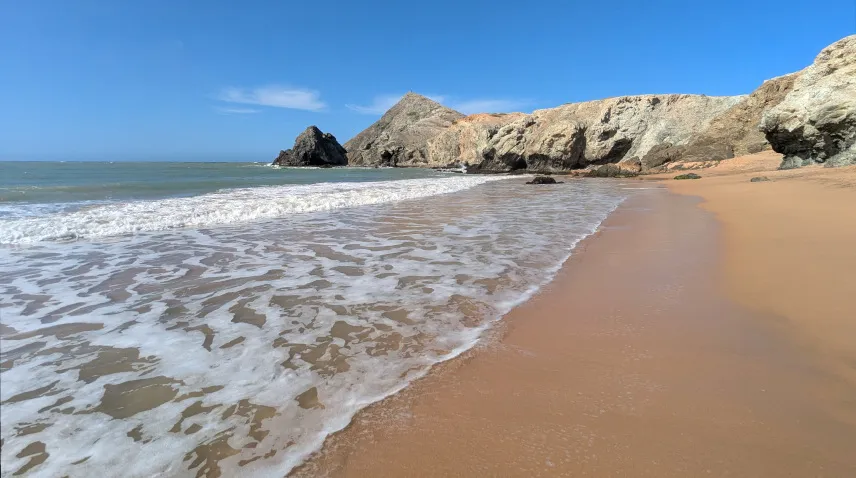
Day 2 – Bahía Portete, Las Dunas de Taroa & Punta Gallinas
Morning: After a yummy breakfast, we drove to our first stop of the day, Bahía Portete. On the way, we passed the wind turbines of Parque Eólico Jepíracho and the first road blockages from locals started – they would keep on going the whole day.
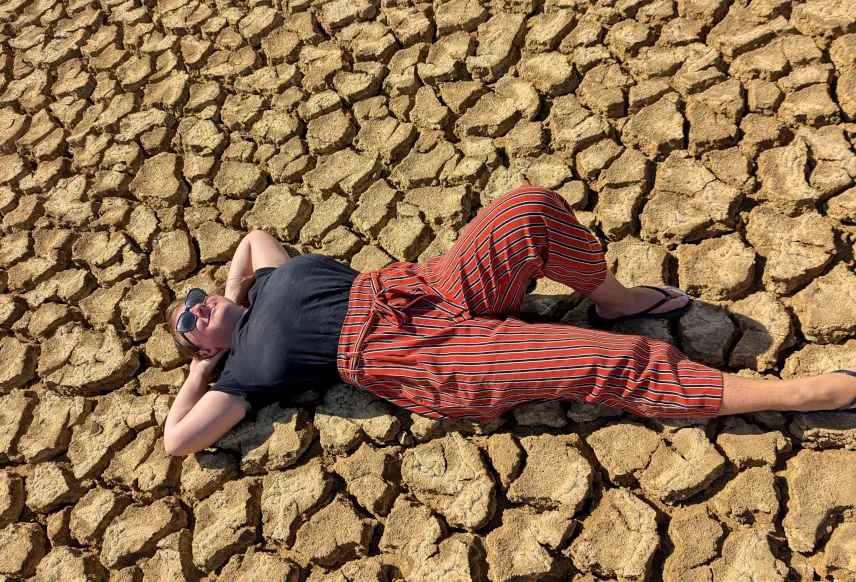
Afternoon: In the afternoon, we reached Las Dunas de Taroa where we first had lunch. Here, we had the option to go sandboarding, swim in the sea, or relax in a hammock – we did all three.
For sunset, we went to Faro Punta Gallinas, the northernmost point of the South American mainland.
We had dinner at our hotel in Punta Gallinas and went to bed early again.
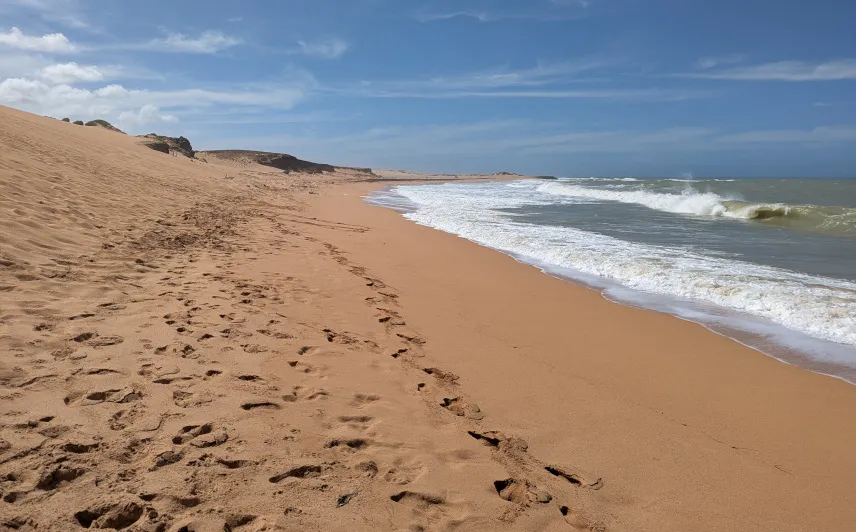
Day 3 – Drive to Mayapo
Morning: After breakfast, we started our journey back towards Riohacha. Along the way, we had some offroad fun and did some picture stops to interrupt the long drive.

Afternoon: As soon as we arrived at the beaches of Mayapo, we had lunch as all of us were starving. As none of the group had any obligations in the evening, we spent quite a lot of time bathing and relaxing before we went back to Riohacha.
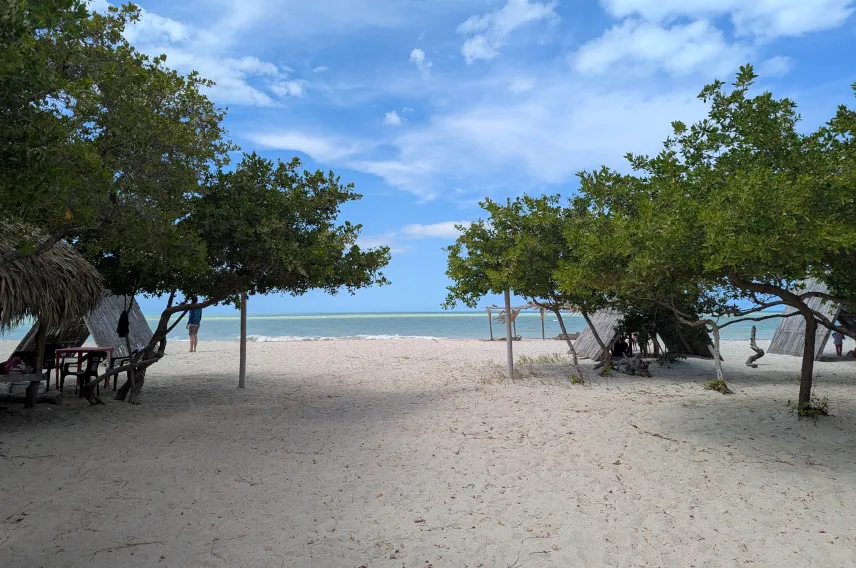
La Guajira Tour – Our Honest Review
Let’s get the elephant out of the room first: This tour is a Spanish-speaking tour. We did get an English introduction in the tour office and you can also pay extra for an interpreter.
Furthermore, this is not a luxury experience. You’ll spend long hours driving offroad. We made regular stops to take pictures, stretch our legs and use the bathroom though.
The accommodations are clean but basic – expect cold water or even bucket showers. We slept in hammocks in both accommodations and both times, we had loads of space, lockers, and power outlets nearby.
Plus you’ll see a lot of poverty. If you have read about La Guajira, you’ll probably know that you’ll encounter a lot of adults and children erecting road blockages along the way asking for money to go through them. This creates a vicious cycle because if you’re begging on the road, you can’t go to school. No education means that your situation probably won’t change in the foreseeable future. Fortunately, our tour guide took great care of the situation. We would be extremely reluctant to go without a guide!
Speaking of our guide: he was absolutely lovely. He was our driver and guide in one person and did a great job at both. The only negative thing about him was that he was too kind to keep some of the other travellers on time – quite to our annoyance.
The food is yummy. You get to choose from a variety of dishes (fish, goat, chicken,…) and you can even opt to pay extra for specials like lobster.
As we mentioned above, most travel agencies seem to have the same itinerary. In fact, we even had people from different travel agencies in our car. We slept in different accommodations but otherwise enjoyed the exact same tour. By the way: The Colombians in our group paid the same amount of money as us.
The scenery in the La Guajira desert is absolutely breathtaking. We loved seeing the sand dunes meeting the sea, driving along cactus-lined roads, and watching spectacular sunsets.
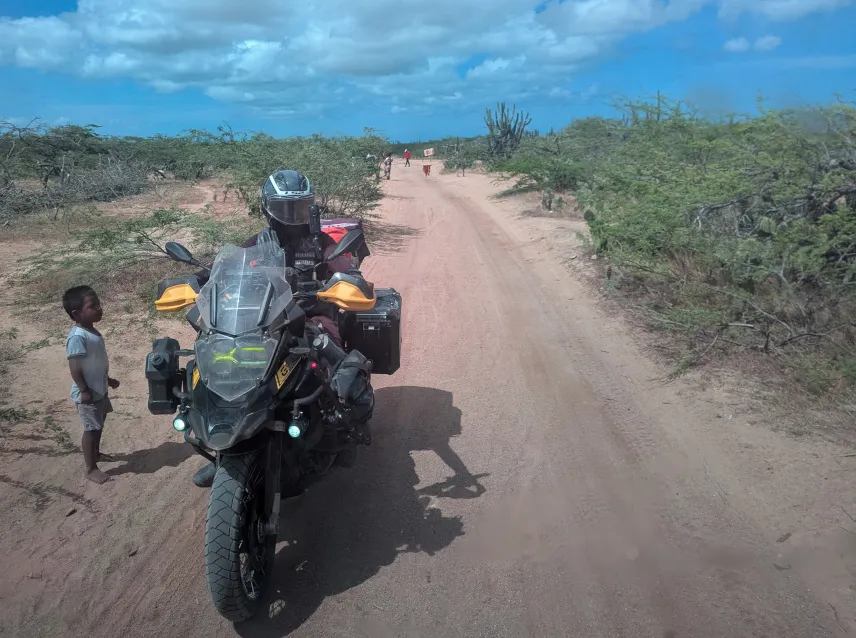
What Other Travellers Say About the La Guajira Tour
⭐ Rating: 5 / 5 (2 reviews)
Traveled with another, in a group of six in total + guide. We are very satisfied with the tour. Good accommodation, good food and great viewpoints. We were not aware of how many children/women came to ask for snacks, coffee etc. during the drive. The driver handled this but it surprised us.
– GetYourGuide traveler (see more reviews)
What Does the La Guajira Include?
The La Guajira tour we did includes:
- Activities in the itinerary.
- Accommodations (hammocks included, beds for an additional charge).
- Food: 2 breakfasts, 3 lunches, 2 dinners.
- Transportation by van in shared capacity for 6 people.
- Spanish-speaking guide.
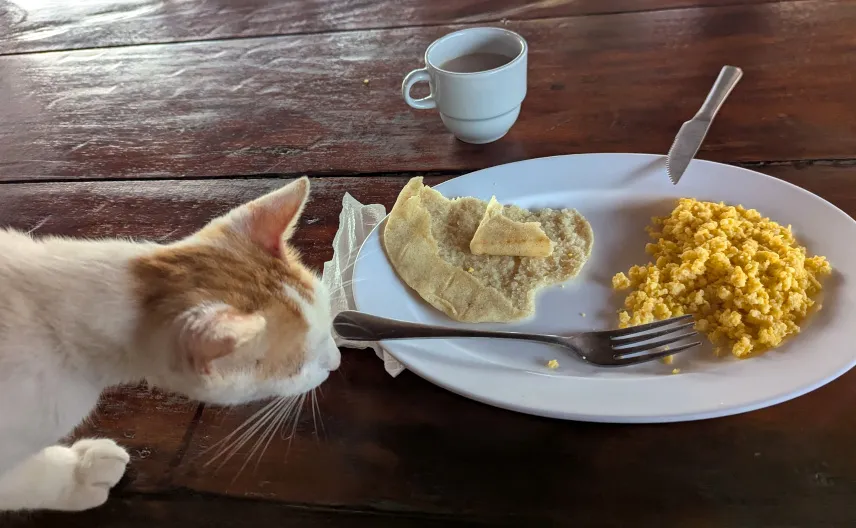
La Guajira Tours FAQ
What to Bring on La Guajira Tours?
This is what we recommend to bring on a La Guajira tour:
- Small backpack
- Sunglasses, sun hat, & sunscreen
- Swimwear
- Change of clothes & toiletries
- Closed-toe shoes and sandals
- Cash
- Water & snacks
- Disinfectant & toilet paper
- A lock if you sleep in a hammock
- Earplugs and an eye mask if you sleep in a hammock
- A jacket, long trousers, and socks for the night if you sleep in a hammock
What’s it like to Sleep in a Hammock?
We slept in a hammock quite a lot on our trip to Colombia (e.g. at El Arca or Tayrona National Park) so we knew the drill by this point. The hammocks or chinchorros in La Guajira are extremely spacious. We were given blankets in both hotels so we didn’t feel cold at all.
You have to expect the hammock to sway a bit in the wind. Additionally, you can’t lie completely flat – you either lie in a curve or diagonally. You also need to be aware that you’ll sleep “out in the open” which means that there’s no acoustic divide between you and your neighbours and surroundings.
We were knackered in the evenings so we just put in our earplugs and on our eye masks and slept like babies.
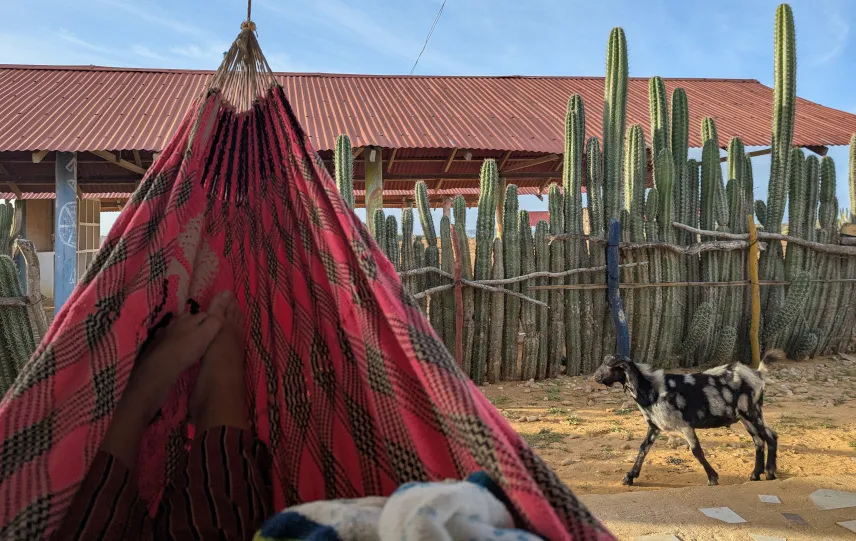
WiFi and Power on La Guajira Tours
We had absolutely no mobile data connection during the whole trip. That’s why we were pleasantly surprised that both of our accommodations on the tour had a decent WiFi connection.
There were also power outlets to charge our phones. The times were limited but it wasn’t a problem.
Conclusion: Is the La Guajira Worth it?
Should you visit La Guajira? Yes – but only if you know what you’re signing up for.
La Guajira offers one of Colombia’s most unique and remote travel experiences. The dramatic desert landscapes meeting the Caribbean Sea, the breathtaking dunes of Taroa, and the stark beauty of Punta Gallinas make this tour visually unforgettable. If you’re craving adventure, raw nature, and off-the-beaten-path travel, La Guajira delivers in full.
That said, this is not a luxury trip. Accommodations are basic, you’ll spend long hours in a car (often off-road), and you’ll witness real poverty – including children begging. It’s emotionally confronting and logistically challenging.
Still, the experience is deeply rewarding – not only for the landscapes but also for the cultural insight and the sense of remoteness that few places offer anymore. As long as you're mentally prepared, physically flexible, and have a bit of adventurous spirit, La Guajira is absolutely worth it.
By the way: We much preferred La Guajira to the Tatacoa Desert.
Here’s our full Tatacoa Desert tour review:
Disclaimer: This post was not sponsored. This post contains affiliate links. If you use these links to buy something we may earn a commission. You would help us a lot if you do so. Thanks.

